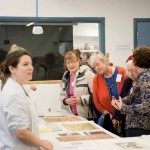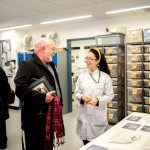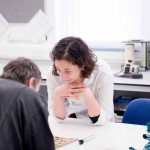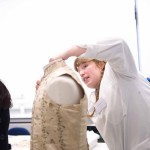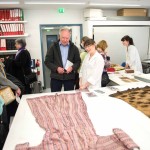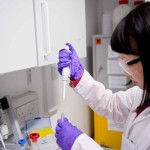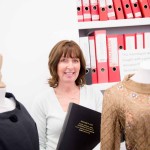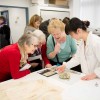
by Karen Thompson, Conservation Teacher.
The Centre for Textile Conservation and Technical Art History held its annual open day on Wednesday 19th March 2014. This is an opportunity for the students and research and teaching staff to show the projects that they are currently working on and to meet other museum professionals, funders as well as people interested to gain an insight into the work of a textile conservator and the technical art historian.
The first year students presented an excellent array of projects demonstrating the skills they have been learning involving the cleaning, stabilisation and mounting of historic textiles. Examples included whitework costume and embroidered samplers. The students talked to the visitors about the cleaning strategies they used and the challenges of managing fugitive dyes and handling of three dimensional objects. Two students presented their work involving the cleaning and stabilisation of clothing from a late nineteenth century doll. Creative solutions to protect a damaged ribbon and re-create the missing loops from a knitted glove were displayed and discussed. A football shirt worn in a Scotland vs England match in 1906, covered with mud from the pitch had been sent to the Centre for cleaning. This provided an excellent opportunity for the student to raise the concept about the significance of dirt and whether the shirt should be cleaned generated lots of debate amongst the visitors.
First year students: Gennifer Majors, Maria Kinti and Geraldine Sim
The second year students presented a wide range of projects. Function and manufacture were often at the forefront of many of the discussions taking place. An unusual woman’s early twentieth century motoring hat with lace veil and a mica visor attracted much interest. There was much debate about its function; many visitors thought it looked more like a bee-keeper’s hat! A Maori cloak with feathers from the Hunterian Museum and Art Gallery attracted a feather expert who was able to offer suggestions as to the type of bird feathers that had been used to decorate the cloak and their significance. Barkcloth pieces from the Royal Botanic Gardens, Kew fascinated a paper maker/artist who was interested to see the overlap with barkcloth and paper production. An eighteenth century French bead purse was challenging to see for even those with 20/20 vision. Visitors marvelled at its construction and conservation which involved tiny seed pearls that had holes too small to pass even our smallest beading needles, but one visitor was able to suggest how this may have been made. It is this exchange of ideas and knowledge that make the day so interesting for visitor and student alike.
Second year students: Maria Grabowska, Rosie Chamberlin and Melissa Bolin
The contrasting work at the Centre was highlighted by the work of our research staff and PhD students, Jing Han and Julie Wertz. Jing Han, a PhD student, presented her work on understanding the dyes and dyeing methods used in China between the sixteenth and eighteenth century. Caroline Ness, who has just completed her PhD exploring the work of the fashion designer, Mattli brought the focus more up to date. Margaret Smith, University teacher and researcher, presented some of the work being undertaken by the Technical Art History students and the research she has been involved in looking painted textiles which was a great opportunity to demonstrate the overlap of textile and painted surfaces. Philippa Duffus, researcher, showed the range of analysis and research being carried out including talks about accelerated ageing and its value in understanding the degradation of textiles and the materials we use. The concept of ageing was an anathema for many people who considered that staying young was what mattered and offered her anti-ageing creams instead!
Research staff and phD students: Jing Han, Dr Caroline Ness, Dr Philippa Duffus and Dr Margaret Smith
The fabulous spring sunshine encouraged lots of people to venture out to visit us and we had an excellent turn out with over 130 visitors. One of the great things about the day is the opportunity to meet such a wide variety of visitors. It included colleagues from the museum world including conservators and curators from the Museum of London, People’s History Museum and Glasgow Museums; colleagues from other departments within the University as well as other universities; and funders, including a representative from the Dyers’ Company, and TCCF Trustees who generously support the students in their education and the work of the Centre. Other visitors included artists, weavers, volunteers from historic houses, friends and family and many more. The students buzzed with enthusiasm as they talked to the visitors and the visitors marvelled at their work. It was a great day and we’re looking forward to doing it all again next year!


